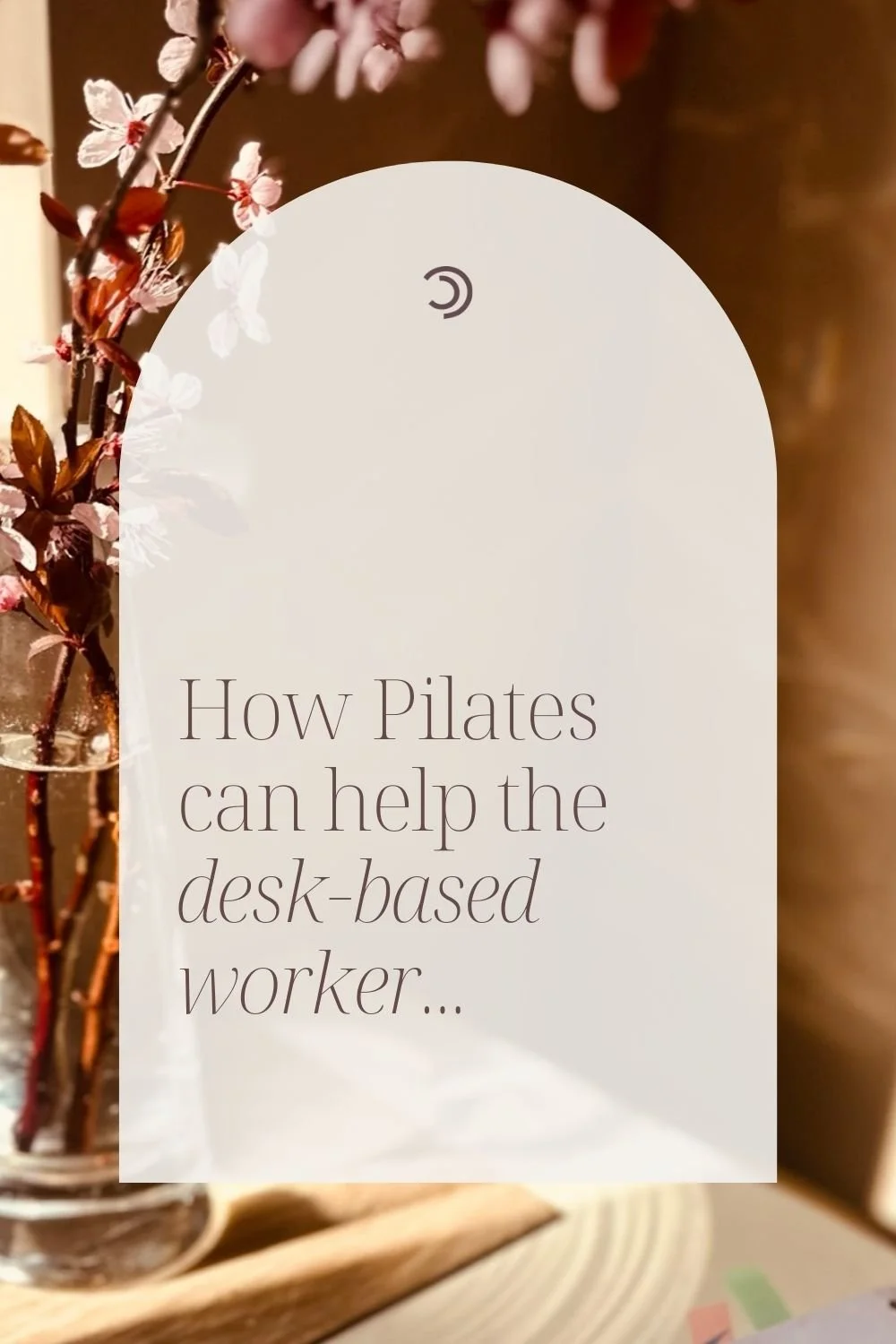Sedentary bodies and busy minds - How Pilates can help the desk-based worker
Is this your ‘all-day’ environment?
So, for how long have you been sitting today? 5 hours, 7, 8 hours or more?
Whilst ‘sitting’ in itself is not inherently bad, the number of hours being sedentary can have major health implications.
In 2019, the NHS suggested that many adults spend around 9 hrs sitting each day. With the continuing rise of a Digital Culture, compounded by the ongoing Covid-pandemic, hours spent sitting is even further on the increase. A Kent University study (cited in Gainsbourg, 2020) found that participants were sitting for an additional eight hours a week since transitioning to remote working and learning.
Even if you are not at a desk all day for work, chances are you are spending hours sitting, perhaps watching TV, being on a ‘phone, laptop or other device. You could also be doing administrative tasks, or, dare I say, just being distracted by the latest news or social media feeds. I’ve been reading ‘In-distractible’ by Nir Eyal to try and identify my own patterns in this regard, but guess what? I get distracted from even sitting and reading a book for any great length of time)!!
“You may be going from your desk-based job to your car, or sitting on a train to commute (or in the not so distant past, spending hours on a flight), and then going home to sit on more devices and/or watch Netflix….and so the inactivity continues.”
Personally, in my academic career, and particularly whilst studying for my Doctorate, I experienced long hours at a desk, and also experienced many symptoms of physical pain; lower back pain and sacro-iliac joint dysfunction, headaches and shoulder pain and certainly hip ‘tightness’. Practising Pilates certainly brought relief from these conditions over time, and I was converted to the transformational effects of the practice
“The World Health Organisation suggests that for adults (aged 18-64 yrs.) ‘physical activity confers benefits for the following health outcomes: all-cause mortality, cardiovascular disease mortality, incident hypertension, incident site-specific cancers, 2 incident type-2 diabetes, mental health (reduced symptoms of anxiety and depression), cognitive health, and sleep’. ”
— World Health Organisation’s (WHO) Report on Physical Activity and Sedentary Behaviour (2020, p12)
Here are the latest WHO guidelines for adults in terms of Physical Activity:
World Health Organisation physical activity guidelines for adults
It is of course great if you find a physical activity that you enjoy, and which is of moderate or vigorous intensity (Pilates would be considered moderate, but a good teacher will incorporate a good deal of strengthening exercises too).
“Arguably, if you have a busy job, and you/re exhausted at the end of the day, it can be very hard to incorporate exercise, unless you make it habit. Can you afford not to, however? ”
From a physical standpoint, being inactive can present itself in a number of ways that can impact your movement. Back pain is probably the number one complaint that I see in the Pilates studio and this is often compounded by ‘Gluteal Amnesia’ – the laxity of the major muscle group in our backsides that is a key muscle for propulsion and power. Marissa Gainsbourg (2021) sites this beautifully as ‘Lazy-Ass Syndrome’
The Role of Pilates
In relation to sedentary lifestyles, in the Pilates studio, I see shoulder and neck tension, headaches, and hip pain, often brought about by tightness in the hip flexors. Importantly, it’s the stiffness of these muscles in relation to the muscles of the core that can create problems (hence pain that is often bought on by moving from sitting to standing, creating ‘sheer force’ in the lower back).
“The value of Pilates in promoting ‘core strength’ is key here. Both the Pilates equipment, and mat work can help address these issues through segmental movement of the spine, exercises to spontaneously engage the core and to bring awareness to alignment, and breath.”
Working with a client through breathwork
Pilates is also great for facilitating the ‘distribution of load’. You may not realise, but this often starts in the feet. In his workshop ‘Sitting is the new smoking’, (2014) Dr. Brent Anderson, (leader of Polestar Pilates) identifies that through a sedentary lifestyle, we lose our ability to ‘dorsi-flex’ at the foot. This can have implications for the whole chain of movement in the body.
Foot flexibility is important for absorbing load, and facilitating the natural ‘bone-rhythms’ of the lower extremities, that are evident in the ‘full squat’. Look at the practices of children to squat and play on the floor (and the practices of developing cultures, that still squat to use the toilet, or squat to sit around a low table to eat) and you will see they can squat with ease. In developed countries, we put children in a chair at 3 years old and so the patterns (and problems) arguably begin. The Pilates studio is a great place to explore ‘Footwork’ in many different forms, but a good mat class too will have elements that encourage foot flexibility.
How easily can you squat?
“The physical benefits of Pilates are, quite rightly, promoted heavily in the mainstream. I do believe, however, that the mental health benefits are where Pilates can, and have (for me personally) had a real impact. ”
The stress of modern-day working, and in particular the layered effects of the current pandemic has had, not surprisingly, a real effect on mental health, and anxiety in particular. As a mental health first-aider, (and through personal experience) I recognise that it is very, very easy to get drawn into a negative spiral of ‘what-ifs’ and worst-case scenarios, and if you are an over-thinker, or ‘catastrophiser’ (this used to be me) then you are susceptible to many other symptoms of anxiety.
The body is quite able to work in ‘fight mode’ for a certain period of time. It’s designed to do just that, in terms of protecting us from threats to our wellbeing (Chattergee, 2018). However, when that stress (and resulting physical factors) are constant, anxiety often presents. The key with Pilates practice is that it brings attention to your own body, but in doing so, takes you away from mental overload. ’It’s no coincidence that the first Principle of Pilates is ‘breath’. Bringing attention to the breath through Pilates is key to accessing the parasympathetic nervous system and accessing a sense of calm (see my previous blog – Stress and the Breath).
So, what can you do next?
Your action points can start small. Take a walk first thing in the morning. Set an alarm on your phone at your desk to get up and get moving each hour. And, of course, find a Pilates class, or explore my website and sign up for regular updates. The important thing is to keep moving.
You can also follow me on Instagram @sarahpositivepilatessolihull
Importantly, I will be producing an online course: Pilates for the desk-based worker: a beginner’s guide to improving both physical and mental health.
It will be suitable for any professional worker who wants to get started with Pilates to improve both their physical and mental health. If this is something that you feel you would personally benefit from, or if you are responsible for a seated workforce and want to help improve both their physical and mental health, then please e-mail me to express interest – positivepilatessolihull@gmail.com
See you on the mat!
Sarah
Bibliography
Anderson, B. (2016) Sitting is the new smoking. Pilates Anytime. Timeshift Media, USA.
Chattergee, R. (2018) The Stress Solution. Penguin Books. Random House, UK.
Eyal, Nir (2019) In-distractable: How to control your attention and choose your life. Bloomsbury Publishing, London.
Gainsbourg, M. (2021) Do you have Lazy-Ass Syndrome? Men’s Health, December 2021.
National Health Service (2019) Why we should sit less. Available at https://www.nhs.uk/live-well/exercise/why-sitting-too-much-is-bad-for-us/





